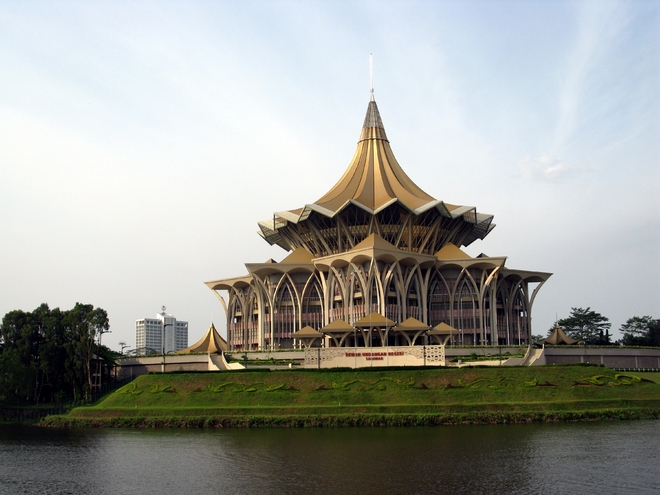Rhythm of Borneo
Anand & Madhura Katti
Borneo’s Kuching city, also nicknamed Cat City, comes alive with the melody of annual Rainforest World Music Festival at the Sarawak Cultural Village situated on its outskirts. It is enveloped by Rainforest Mountains on one side and the South China Sea on the other. The location of the cultural village itself is breathtaking.
Inside the cultural village, one can see the imposing large mural on the front wall of Iban longhouse that has intricate art recapitulating the realms of the rainforest. The curly design inspired by ferns of the rainforest and rooster feathers, both of which are an integral part of everyday life of Borneo tribes, is coloured with natural extracts.
The Sarawak Cultural Village is a purpose-built attraction near Kuching that provides an insight into the region’s rich ethnic diversity. The centre features a collection of seven traditional houses, scattered over 17 acres of landscaped land with the backdrop of Mount Santubong. The orientation tour, along a well-marked trail, reveals unique lifestyles of people who normally dwell in those traditional houses.
The beautiful Iban longhouse built on high stilts comes into the view as one braves to climb up the carved steps of a single log. The verandah with bamboo flooring is spacious enough to support all outdoor activities of house members — like drying of food items, playing music, welcoming guests and chit chatting or just relaxing during the long day.
Baskets, hats, mats and bags made of fine bamboo slits and vividly woven beads are displayed inside the house. Most of the motifs and designs of the ancient forms of vegetable fabric textiles are connected to ceremonial rites and animistic values. Indian traders had introduced backstrap loom to South-East Asia, along with cotton, as an alternative to bark-cloth textile during early centuries of maritime trading. Continued tradition can be noticed through distinctively designed clothes available in Kuching. These also make good buys to take back home.
The Orang Ulu longhouse depicts the lifestyle of upriver dwellers that are made up of tribes like the Kenyah, Kayan, Klemantan, Kelabit, the Lun Bawang, Penan, as well as a few minor tribes of the interiors.
Penan huts, Melanau tall-house, Bidayuh longhouse, Malay house and the Chinese farmhouse at the centre make intriguing visits too. If game for more ethnic experience, one can stay at the traditional houses that are purpose-built by the Sarawak Cultural Centre.
During the music festival, the entire Sarawak Culture Village gets into a celebration mode to welcome music troupes and fans. As many as 27 to 30 music teams from around the world descend in the city of Kuching for the Rainforest World Music Festival, while music fans travel from as faraway places as North America, Africa and Europe. Tribal volunteers dressed in their ethnic costumes provide for a vibrant photo opportunity to visitors. Language is never a barrier, and one can only hear the reverberate cheers of the crowds at the festival.
A visit to the model longhouses at Sarawak Cultural Village creates inquisitiveness in everyone to experience the actual life at a longhouse. It seems even today there are more than 5000 families that continue to live in longhouses in Sarawak and these are open to visitors.
In the Sarawak Cultural Village, there is an opportunity to visit the music workshops and interact with singers. Sarawak designs can be found in different souvenirs like keychains with wood carvings, hand fans and bags and mats made from bamboo at the make-shift shops at the cultural village during the music festival.
Back in Kuching city, the interestingly architectured 215 feet tall city tower offers a bird’s eye-view of the coastal city with abundant rainforest. Colonial architecture is preserved and maintained, as 40 hectares of forest cover surrounding the city centre is a declared protected area by the local government. Traditional Sarawak architecture comes alive in the state parliament building across the river.
The rainforest near Damai beach is refreshing with cool winds blowing from the nearby South China Sea.
Batik sarongs, shirts with local ikat designs and Pua Kumbu, beautiful cotton blanket of Iban tribe at Fabriko make an excellent buy. Design artists from across the world, including some Indian designers, come here to study indigenous ethnic designs. The batik shop on India Street has a wide collection of local textiles, many created by its own designers.
Fine architecture in wood and bamboo at longhouses, intricately carved murals, Orangulu beadwork, bamboo art and ikat designs inspired by the flora and fauna of the rainforest revoke the imagination and appreciation for the rear, nature inspired designs here in beautiful Sarawak region. There is enough memorabilia to carry back to cherish those melodies and beautiful art of Sarawak for a long time.









